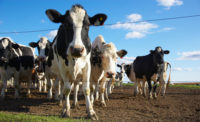Study says choose organic for the cleanest milk
For example, antibiotic residues were detected in 60% of conventional milk samples and none of the organic samples.

Milk is an important part of the human diet. But, not all milk is created equal.
A study conducted by researchers at Emory University, Atlanta, in collaboration with The Organic Center, Washington, D.C., found that a majority of samples of conventional retail milk tested positive for residues of antibiotics – two of which are banned from dairy production -- and used controversial pesticides. Meanwhile, organic milk showed no such contaminants. Residues of growth hormones in conventional milk were 20 times higher than in organic, according to the study, “The Benefits of Organic Dairy.”
Highlights of the findings:
- Antibiotic residues were detected in 60% of conventional milk samples and none of the organic samples. Significantly, 37% of the conventional samples tested positive for sulfamethazine and 26% for sulfathiazole, both of which have long been outlawed in lactating dairy cows. Furthermore, one of the conventional samples contained residue levels of amoxicillin that exceeded the federally-allowed limit.
- Bovine growth hormone (bGH) residue levels were found to be 20 times higher in conventional milk than organic.
- Pesticide residues of chlorpyrifos, atrazine, permethrin and more were found in 26-60% of conventional samples and none of the organic samples. Residues of the restricted-use pesticide chlorpyrifos showed up in 59% of the conventional samples.
"This study is especially exciting because the researchers developed methods that are more sensitive than past analyses, including testing methods that have been used by the Food and Drug Administration (FDA), also the study measured levels of chemicals that were previously unreported. These new methods give us a true picture of the presence or absence of residues in milk. The methodology was proven and solid, and put systems in place to control for results that would inaccurately indicate the presence or absence of the residues [false positives and false negatives]. The statistical significance was so clear and decisive that it gives us confidence that what we found in the study would also be the results of a larger sampling," says Dr. Jessica Shade, director of science programs for The Organic Center. "Milk is a great source of protein and important vitamins and minerals, and we want our children and our families to drink milk. But, not all milk is created equal, as this study demonstrates. This study finds that the presence of antibiotics and pesticides in conventional milk is much more prevalent and pervasive than previously thought, and that organic milk doesn't contain any of these contaminants. We hope this study will let people know that the choice is out there for good clean organic," says Shade.
A nationwide sample of the milk we're drinking
To conduct the study, researchers out of Emory University tested for residues of currently used pesticides and antibiotics in U.S. milk purchased directly from store shelves, comparing conventional milk (35 samples across 18 brands) to organic milk (34 samples across 10 brands).
The milk samples were collected in August 2015 from each of nine regions—California, Great Lakes, Midwest, New England, New York, Northwest, Rocky Mountain, Southeast and Southwest. In each region, 8 half-gallon milk cartons were purchased from one or more retail stores. These included six cartons of 2% milk, three of which were labeled as different USDA-certified organic brands and three labeled as different conventional brands. Two samples of whole milk, one certified-organic and one conventional were also obtained. Flavored and specialty milks were excluded. A total of 69 samples were collected.
The study's findings detected residues of antibiotics and pesticides – in one case above the federally allowed limit for antibiotics -- in the conventional samples of milk, and no such residues in organic milk. Residues of growth hormones in conventional milk were found to be 20 times higher than in organic.
Antibiotics results
Because the overuse of antibiotics can increase resistance to those antibiotics and make them less effective for both humans and animals, the FDA set limits on detectable levels of antibiotics in food. In this study, antibiotics were not found in organic samples, but were detected in 60% of conventional milk samples. Specifically, residues of amoxicillin, oxytetracycline, sulfamethazine, sulfadimethoxine and sulfathiazole were all detected in conventional milk.
Importantly, residues of sulfamethazine were found in 37% of the conventional samples and sulfathiazole in 26%. The use of both of these antibiotics for dairy cows has long been banned by the FDA due to concerns about the impact of sulfa drugs on human health. When cows are treated with sulfa drugs, residues of the drug show up in milk, and exposure to them can lead to health problems in humans.
Residue levels of amoxicillin over the FDA limit
The study noted that testing for amoxicillin was not done as part of an FDA study done in 2015, and that the findings of this study indicate that the oversight of the safety of our milk supply needs to be bolstered.
"While the results of the previous FDA study demonstrated that, with a few exceptions, antibiotic residue levels were within federal safety limits, our finding that multiple samples exceeded them suggests that further strengthening of the monitoring system is needed to ensure the continued safety of the milk supply," says the study.
Growth hormone results
While there is no federal limit set for cow-derived hormones in milk, this study found levels of bGH to be 20 times higher in conventional milk than organic. The study said that since growth hormones are produced naturally by dairy cattle, some level of bGH can be expected in all milk samples. The dramatically higher residues found in conventional milk "suggests that the difference reflects the use of synthetic growth hormones" in conventional dairy, according to the study. Low level hormones identified in organic milk fall in line with a bovine's natural biological cycle when lactating.
Pesticide results
The results found no residues of current-use pesticides in any of the organic milk samples, but residues in up to 60% of the conventional samples.
The researchers tested for a wide variety of pesticides currently used in conventional dairy production. All of the organic samples tested zero for residues of pesticides in current use. However, conventional milk showed residues of different pesticides in 26-60% of the samples. Those pesticides included atrazine (26%), chlorpyrifos (59%), cypermethrin (49%), diazinon (60%) and permethrin (46%).
"While none of the organic milk samples had detectable levels of current-use pesticides, most of the conventional samples did," says the study.
Of note is that conventional milk tested positive for residues of the dangerous neurotoxin chlorpyrifos in 59% of the samples. The pesticide was ordered by a federal court to be banned in agriculture in 2018, but this ban has been appealed by the current administration. California recently announced plans to ban the pesticide, and several other states have started to take action to crack down on the use of chlorpyrifos due to health concerns.
"These results demonstrate that residues of some antibiotics and current-use pesticides were prevalent in the conventionally produced, but not the organically produced milk samples,” according to the authors of the study. “Our findings also demonstrated significantly higher levels of growth hormone levels in the conventional samples."
The importance of organic dairy
Organic dairy is the No. 2 selling category in the U.S. organic industry, according to The Organic Center, with products such as organic cheese, organic butter and organic sour cream all seeing greater sales.
Organic dairy farmers are required to adhere to the federal organic standards that ensure organic dairy is produced sustainably, with the health of the cows and the health of the consumers in mind. Organic dairy means no use of antibiotics, synthetic growth hormones, GMOs or conventional pesticides. In organic dairy, the health and natural behavior of cows are prioritized with holistic and preventative care practices as a primary management strategy. Organic cows are pasture-raised and grazed throughout the grazing season, and all livestock are fed an organic diet.
"There needs to be more research conducted to expand this important study and to test more samples across the U.S.," says Shade. "But, in the meantime, in order to get the important nutrients from dairy, the best choice is organic dairy."
"To our knowledge, this is the first study to compare levels of pesticide in the U.S. milk supply by production method (conventional vs. organic). It is also the first in a decade to measure antibiotic and hormone levels and compare them by milk production type," says the study. "Residues of current-use pesticides and antibiotics appear to be common in conventional, but not organic milk sold through retails stores across the USA. Similarly, growth hormone levels and IGF-1 [insulin-like growth factor 1] were several times higher in conventional milk, which suggests that the difference reflects the use of synthetic growth hormones. The present study's findings suggest that choosing to consume milk produced organically would minimize exposure [to antibiotics, growth hormones and pesticides] and any possible associated risks."
Looking for a reprint of this article?
From high-res PDFs to custom plaques, order your copy today!





